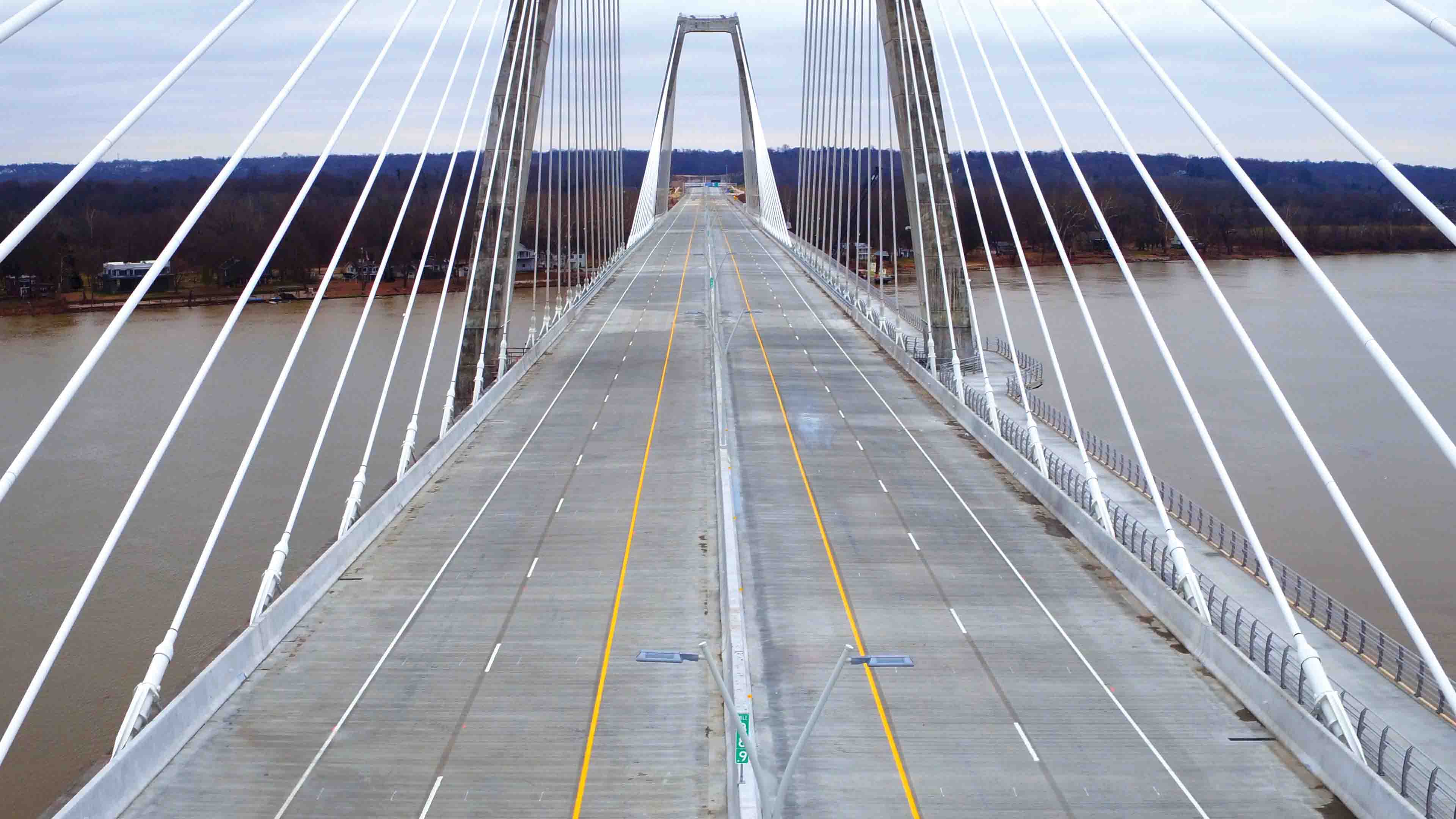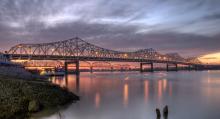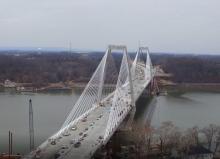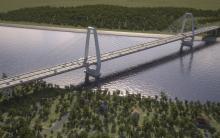
Acquisitive Canadian firm Stantec is snapping up more transportation expertise as it moves out of its home North American market. David Arminas reports.
Last December, politicians from the US states of Kentucky and Indiana celebrated the opening of the second of two major bridges. A ribbon-cutting ceremony took place in cold wintry weather on the new 762m-long cable-stayed Lewis and Clark Bridge. The event marked the finish of the prestigious three-and-half-year Ohio River Bridges Project.
Meanwhile, 3,100km away in even colder Edmonton - one of Canada’s most northerly cities - employees at the head office of consulting engineers
Working with lead tunnel engineer Jacobs Engineering, Stantec recommended epoxy resin bolts based on long‐term performance and speed of installation. More than 1,400 rock anchor bolts were installed on the tunnel portal and approach walls. Stantec worked on design methodology, installation procedures and quality control testing, along with issues encountered during construction (see box on p58).
However, highway and bridge contracts are not the mainstay of the Canadian company which is publically listed on the New York and Toronto exchanges. But many more - and larger - road, bridge and rail contracts are desirable, according to Gord Johnston, executive vice president of Stantec’s infrastructure group. In order to raise Stantec’s profile worldwide, deeper involvement in projects similar to the Ohio River Bridges work, are being sought.
Stantec has around 22,000 employees in more than 400 locations across six continents. In South East Asia and the Pacific region, 400 employees are in Australia, 500 in New Zealand, 150 in Fiji and up to 700 in other countries, including China, Taiwan and Brunei.
However, Stantec is noted more for its work in North America. In fact, the Canadian company gets around 51% of its global revenue from the US market, according to its 2015 annual report. Transportation design contracts account, as yet, for up to only 15% of global income.The highly acquisitive group has set itself the goal to be a top 10 global design firm within a decade, so says its website. “It’s a bold objective, but it’s one we take seriously,” the message states. Transportation engineering companies – including outside North America - are on the hit-list.
"In the past decade, we’ve closed over 100 acquisitions of all types,” Johnston told
“We don’t view ourselves as a Canadian company but more a North American company that is becoming more global,” he says. “Now, with MWH, we are expanding to become more of a global firm.”
It hasn’t been, and won’t be, acquisition at any cost, he says. “Cultural fit is very important for us. We don’t buy heavy machinery or manufacturing capability. When a firm joins Stantec, employees bring their hearts and minds that helps us to grow. We’ll take the best parts of other firms’ cultural attributes and add them to that of Stantec.”
Intellectual capital
Being in the top 10 global design firms doesn’t mean a certain level of revenue above other firms. “For us, a revenue target or ENR ranking isn’t the goal,” said Johnston. “Our goal is to be in a top tier-position in all the markets that we serve, to be in a virtuous circle. If you can attract the best staff, then you get the best clients, then you get the best projects, which in turn attracts the best staff.”
Stantec is, however, ranked by the US-based magazine ENR – Engineering News-Record - in its 2016 list of Top 100 Design Firms. Stantec is keeping good company:
Stantec was also just behind Houston-based KBR at 17. How sweet it is. In late 2015, Stantec acquired KBR’s Infrastructure Americas division for $19 million. With offices in Texas and Alabama, Infrastructure Americas brought 180 professionals with experience in transportation, water, wastewater and aviation over to Stantec.
Infrastructure Americas also brought to Stantec a higher transportation profile, such as design work on the design-build Highway 181 Harbor Bridge Project in Corpus Christi, Texas.
The acquisition also brought design work on the Secondary Highway 288 Toll Lanes Expansion Improvement Project in Harris County, Texas. Nearly 17km of new toll lanes will be built, along with the installation of new toll infrastructure and the establishment of toll operations and maintenance.Stantec closed the deal on Infrastructures Americas in 2015 only weeks after it picked up Fay, Spofford & Thorndike, a consulting firm in Massachusetts employing 280 people in nine states. Apart from roads and bridges, FST’s activities span airports, railways, marine, wastewater treatment, trail design and environmental services.
Smart move
Stantec is also making sure it will be involved in the increasingly important smart highways and autonomous, or connected, vehicle market. “We’re trying to stay at the cutting edge of this technological wave that is coming,” says Johnston. “So we’re engaged with a number of autonomous vehicle testbeds in North America, such as the 2,025-hectare GoMentum Station near Concord, California.”The GoMentum testbed, a former naval weapons site, has more than 30km of road and is now the largest secure testing facility for autonomous and connected vehicles in the US. Contra Costa County, near San Francisco, set up the Contra Costa Transportation Authority, a public-private partnership, to bring together automobile manufacturers, communications companies, technology companies, researchers and public agencies to work at the site. Research and testing includes private, shared, and commercial vehicles, in a multimodal environment. Stantec is serving as program manager for GoMentum.
In Canada, Stantec is the lead civil engineer for the Edmonton testbed of the federal Canadian government’s AURORA project – AUtomotive test bed for Reconfigurable and Optimised Radio Access – for autonomous vehicles. In Edmonton, research is being led by the University of Alberta Centre for Smart Transportation. Several city roads have been equipped with vehicle-to-infrastructure technology. For example, a pedestrian wanting to cross the road activates a walkway which in turn communicates with the first approaching car to slow it down, which in turn communicates with the car directly behind it to slow down.
“We also have a strategic partnership with EasyMile that has developed a fully autonomous vehicle carrying up to 12 people.” EasyMile, with 60 employees, is a European private company in Toulouse, France.
The company’s EZ10 vehicle shuttles people who have parked their cars in, say, a large parking lot for a train station and delivers them to the train terminus. This spring, EasyMile, together with public transport company Kolumbus and Forus PRT, will start a pilot shuttle service around the Forus PRT business park in Stavenger, Norway.
Back in the US, Stantec recently announced it will work with Local Motors, a technology company that designs, builds and sells vehicles, to jointly develop the self-driving Olli, a cognitive shuttle bus. The vehicle’s target market is urban transportation agencies, city departments, universities, hospitals and private companies.
Stantec may well be looking toward the global market, but Edmonton, where Don Stanley founded the company in 1954, will remain its home base. In 2018, the company will move 1,700 employees from several offices around the city into what will be Edmonton’s tallest building, a mixed use structure at 224m. Stantec designed the building, now under construction, for a developer with themselves in mind as the tenant. At 62 storeys, the structure is aptly named Stantec Tower.
Harbor Bridge Project in Corpus Christi, Texas
In July 2015, the
The structure will be the longest cable-stayed bridge in the US and allow larger ships than is now possible to access to the city’s port, according to a statement by
The project also includes works on the US 181 motorway, on which the bridge is situated, and on the I-37 and SH-286 motorways.
The new structure across the entrance channel of the Port of Corpus Christi will have six spans, with a 505m main span – the longest between supports for a cable-stayed bridge in the US. The bridge’s 62m clearance will allow the largest ocean-going vessels, including those that cross the expanded Panama Canal, to access the Port of Corpus Christi.
Flatiron/Dragados will demolish the existing Harbor Bridge which opened in 1956 to replace a drawbridge. It now handles 26,000 vehicles per day. In December 2011, an LED lighting system was installed at a cost of around $2.2 million.
Ohio River Bridges Project
The opening of the 762m cable-stayed Lewis and Clark Bridge in December marked the end of the ambitious US$2.3 billion Louisville-Southern Indiana Ohio River Bridges Project.
The Bridges Project is the largest road and bridge development jointly undertaken by the neighbouring US states of Indiana and Kentucky. The overall 3.5-year Bridges Project is made up of two bridge sub-projects - the Downtown Crossing and the East End Crossing.
Kentucky was responsible for constructing the $1.3 billion Downtown Crossing – finished in December 2015. Indiana has been working on the recently opened $1 billion East End Crossing. All-electronic, no-stop tolling is used on the entire Bridges Project that includes a new downtown Louisville interchange and 12 lanes on the two interstate bridges linking Kentucky and Indiana.
Lead contractor Walsh
The East End Crossing consists of nearly 14km of new road, including two parallel 518m tunnels and the new 762m cable-stayed Lewis and Clark Bridge. The new bridge and road connect the eastern edge of suburban Louisville in Kentucky and an area just east of Jeffersonville city in Indiana. The Indiana Finance Authority and
Stantec Consulting Services, through its Ohio office, is responsible for designing rock anchors for permanent cut slope support for the East End Crossing. Working with lead tunnel engineer, Jacobs Engineering, it recommended epoxy resin bolts based on long‐term performance and speed of installation. More than 1,400 rock anchor bolts were installed on the tunnel portal and approach walls. Stantec worked on design methodology, installation procedures and quality control testing, along with issues encountered during construction.








